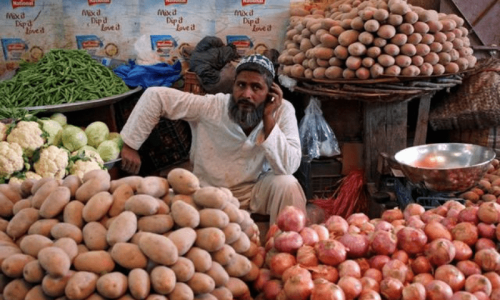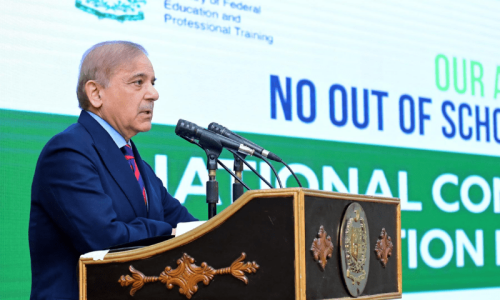I HATE to be the bearer of bad news all the time. But circumstances don’t permit otherwise. In the last monetary policy statement of July 31, the State Bank said “inflation is likely to remain on downward path over the next 12 months”. But it is difficult to see how this will happen.
There are a couple of reasons to believe why inflation may have peaked. First is what they call the “base effect”, which basically means that inflation was so high the same time last year that the percentage increase between the price level back then and now will be small. What this means is that the rate of growth will be small, not that inflation will ease. Given how stupendous high inflation already was the same time last year, this is small solace.
Second, the State Bank also pointed to “expected lagged impact of the accumulated monetary tightening so far, budgeted fiscal consolidation, and the tepid growth outlook for FY24” as reasons why inflation may slow. This is possible, although today the drivers behind surging inflation have multiplied and how they behave in the months to come is hard to forecast. What is also hard to forecast is whether or not the “budgeted fiscal consolidation” will actually materialise, and whether the “tepid growth” will actually dampen inflation more than the factors that are actually driving it.
Here is what has happened. The month of August has seen two massive fuel price hikes. The landed cost of petrol, for example, rose by Rs30 per litre between both of these. This is almost entirely due to the rise in international prices, as well as some amount of residual price correction that was left over by the outgoing government from the month of July.
Monetary tightening on the one hand, and printing money on the other, are likely to cancel each other out.
Then the month of August also saw the resurgence of exchange rate pressure, with dollars once again largely disappearing from the open market, and LCs becoming hard to open for businesses. Once the devaluation settles (it had not till the writing of this piece), the next round of fuel price adjustments at the end of August will have to reflect this too, since fuel is imported in dollars and sold in rupees.
So already we have a vicious circle forming. Devaluation drives inflation, inflation drives devaluation. This may sound puzzling and counter-intuitive to some, but these two factors are linked to each other in a very deadly way, and once this cycle gets going, breaking it becomes very hard.
What gets this cycle going? The answer is simple: excess money supply creation. This is where the story needs a little background. Total money supply (what economists call ‘broad money supply’) has been doubling every five years over the past 15 years. The past five years are no exception. The pace of money creation accelerated during the Covid period and gathered steam thereafter. Despite strenuous efforts by successive governments to halt this, the authorities are now unable to do so.
Here is how this vicious circle works. In the Covid years they created money through low interest rates and refinance facilities to boost growth in the economy. When the Fund programme had to be restarted, they had to not only roll this ‘accommodative monetary stance’ (to use the parlance of central bankers and global lenders) but surrender altogether the power to run these refinance facilities and use printed money to pay for the government’s bills. This was done via the amendments to the State Bank Act that were hurriedly passed by parliament in early 2022.
But right as they turned off one tap, they turned on another. In December 2021, they started a new way of injecting printed money into the system called ‘long-term Open Market Operations’. Here is how these work: the State Bank prints money, lends this to the banks at a certain percentage, the banks lend on to government at a higher percentage still. By today, the total amount of money injected into the system via these long-term outstanding OMOs is more than 20 per cent of the total broad money supply — a stupendous percentage.
These OMOs continued through 2022, and well into 2023, because otherwise the state itself would go bankrupt, given its interest expenditures were larger than its net federal revenues (total tax collection minus transfer to the provinces).
Ironically, this was also the time when the State Bank was hiking interest rates. The years 2022 and 2023 saw the key interest rate rise to 22pc, a historic high. This is what the State Bank is referring to when it says the “expected lagged impact of the accumulated monetary tightening” is likely to serve as a drag on inflation in the months to come.
But the problem here is that high interest rates may well be draining surplus liquidity from the system, but the state’s fiscal requirements are necessitating further liquidity injections. In short, they are draining liquidity from the system with one hand, and pumping more liquidity with the other. So the monetary tightening on the one hand, and printing money on the other, are likely to cancel each other out, unless they stop the OMOs altogether.
So we have a dilemma on our hands: how to arrest the single-most important driver of growth — money supply growth. And we have an interim government, which can do some, but not all, of what is required. The increases in inflation may start to taper off (though I wouldn’t even bet on this). But a dramatically new reality on the price level lies ahead of us. The accumulated pressures from the money supply creation underway for three years now have not dissipated. By the time they do, things will not be the same for most of us.
The writer is a business and economy journalist.
Twitter: @khurramhusain
Published in Dawn, August 17th, 2023
















































Dear visitor, the comments section is undergoing an overhaul and will return soon.